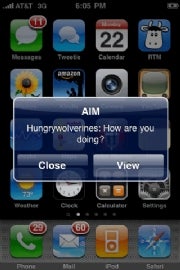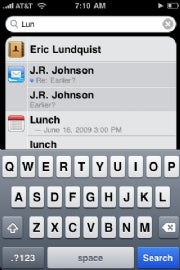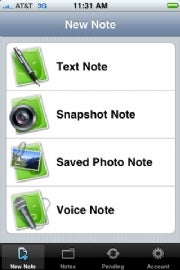But Apple has been busy, too. Last week, it released its third major version, iPhone OS 3.0, which ships on the iPhone 3GS and is available as a free upgrade for owners of previous iPhones (and as a $10 upgrade for iPod Touch owners). It remains the next-generation mobile OS to beat.
The new iPhone OS 3.0 boasts more than a hundred new features--some of them subtle and whimsical, others more overt and useful. Version 3.0 represents an evolutionary, not revolutionary advance. Its stiffest competition comes from two operating systems that didn't exist when the iPhone was first announced and that seem to have drawn plenty of inspiration from Apple's phone: Android and WebOS. Except for its lack of mutitasking for third-party apps, however, iPhone OS 3.0 feels richer and more mature than either of those two OSs.
Read on for a look at how the latest iPhone OS compares with Google's Android, Microsoft's Windows Mobile, Nokia's Symbian S60 5th Edition, Palm's WebOS, and RIM's BlackBerry OS. I judged the five operating systems on their capabilities, ease of use, and visual panache, and I assessed both their standard applications and associated third-party programs.
Apple iPhone OS 3.0

 How it works: As you zip around the iPhone 3GS's multitouch interface with your fingertips, hardware and software blur into one pleasing experience. With other operating systems, it's all too easy to get lost in menus or to forget how to accomplish simple tasks; iPhone apps, however, are remarkably sleek and consistent. Version 3.0 fills in most of the holes that remained in version 2.2 by adding cut, copy, and paste, excellent OS-wide search, and better support for using landscape mode. It also gives third-party developers new features to tap into--for example, subscription services within apps, peer-to-peer networking over Bluetooth, and the ability to alert a user even when an app isn't running. (The OS still lacks true multitasking for third-party programs, however, which is probably its most serious omission at this point.)
How it works: As you zip around the iPhone 3GS's multitouch interface with your fingertips, hardware and software blur into one pleasing experience. With other operating systems, it's all too easy to get lost in menus or to forget how to accomplish simple tasks; iPhone apps, however, are remarkably sleek and consistent. Version 3.0 fills in most of the holes that remained in version 2.2 by adding cut, copy, and paste, excellent OS-wide search, and better support for using landscape mode. It also gives third-party developers new features to tap into--for example, subscription services within apps, peer-to-peer networking over Bluetooth, and the ability to alert a user even when an app isn't running. (The OS still lacks true multitasking for third-party programs, however, which is probably its most serious omission at this point.)
How it looks: Terrific. Everything from the sophisticated typography to the smooth animation effects contributes to the richest, most attractive environment ever put on a handheld device.
 Built-in applications: What's good is great--especially the Safari browser, which does a remarkable job of simplifying navigation through sites that weren't designed for viewing on a smartphone. The OS's music and video programs are of iPod caliber, too. But as a productivity tool, the iPhone still lacks depth in some areas. For instance, you get no apps for editing documents or managing a to-do list. (Both are available from multiple third-party developers, however.)
Built-in applications: What's good is great--especially the Safari browser, which does a remarkable job of simplifying navigation through sites that weren't designed for viewing on a smartphone. The OS's music and video programs are of iPod caliber, too. But as a productivity tool, the iPhone still lacks depth in some areas. For instance, you get no apps for editing documents or managing a to-do list. (Both are available from multiple third-party developers, however.)
Apple could stand to learn a trick or two about Web integration from WebOS (which tightly integrates its apps with Facebook and other Web services) and Android (which logically works extremely well with Google services such as Gmail).
 Third-party stuff: Thanks to Apple's hugely influential App Store, the iPhone has gone from having no third-party apps to having more than 50,000 (most of them inexpensive or even free) in less than a year. The best ones, such as Facebook and the Evernote note-taker, are outstanding. But the limitations that Apple imposes on third-party apps--they can't run in the background or access data other than their own--put major obstacles in the way of everything from instant messengers to office suites. And as the sole distributor of iPhone software, Apple has declined to make available some useful applications that developers have submitted.
Third-party stuff: Thanks to Apple's hugely influential App Store, the iPhone has gone from having no third-party apps to having more than 50,000 (most of them inexpensive or even free) in less than a year. The best ones, such as Facebook and the Evernote note-taker, are outstanding. But the limitations that Apple imposes on third-party apps--they can't run in the background or access data other than their own--put major obstacles in the way of everything from instant messengers to office suites. And as the sole distributor of iPhone software, Apple has declined to make available some useful applications that developers have submitted.
Bottom line: Despite the strides made by Android and WebOS, iPhone OS 3.0 stands as the most enjoyable and intuitive phone operating system available today.

No comments:
Post a Comment